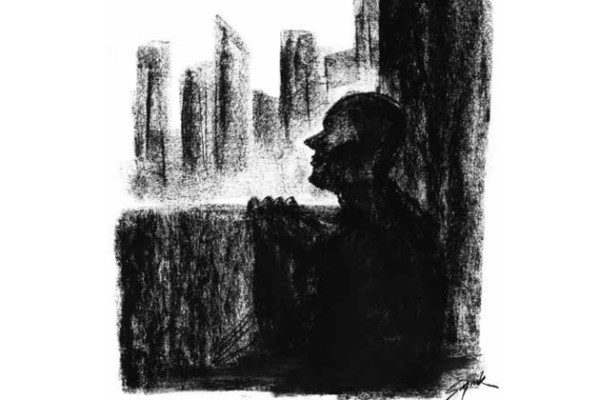Sujoy Ghosh's much-hyped short film fails because he misses the cultural nuances of the myth of Ahalya, says Soumabrata Chatterjee.
If you are a fan of James Wan, the Malaysia-born director of Saw, Dead Silence, Insidious, The Conjuring and Furious 7, chances are that you are smitten and/or horrified by the freakish Billy the Puppet, or the scene in Dead Silence where innumerable dolls turn their heads and look at you in unison. You probably know who Ed and Lorraine Warren were; in case you don’t, they were investigators of the paranormal, associated with cases like the Amityville Horror of 1976, the 1986 haunting in Connecticut, the 1971 case of the Perron family in Rhode Island, later adapted in The Conjuring. You’d be even more intrigued by their mesmerising story of a Raggedy Ann doll being possessed by the spirit of a girl called Annabelle Higgins. You might even have watched YouTube videos about the Occult Museum in their home.
Sujoy Ghosh’s latest directorial venture Ahalya, with its tale of haunted dolls, ventures into this amorphous space of horror-topia. His biggest success with the film is that he places the horror inherent in people turning into dolls in a cultural context, adapting the story of Ahalya from the Uttara Kand of the Ramayana in a more urban setting. But first, we need to know a little more about this mythical figure.
The name ‘Ahalya’ literally translates to the absence of ploughing, read deformity. Brahma is said to have created her as the epitome of perfection, which he then gifted to the sage Gautam. The exact process of her creation differs in the various versions of the epic—in one, she is born out of pure creative energy; in another, she is created out of water in order to insult Urvashi; yet another tale has her being created out of the ashes of the sacrificial fire of the seven maharishis, of whom Gautam was one. Gautam cursed her, turning her into stone, for having sex with Indra, who posed as her husband. Ram turned her back by touching her with his foot.
A website I came across employs a truckload of celestial metaphors to explain away this case of victim blaming. The writer replaces all mention of sex in the story with vague mystical terms and promotes the view that seeking materialistic pleasure was Ahalya’s undoing; she should have been practising “spiritual sadhana” instead.
Now, you must be wondering why Ahalya had to be punished for Indra’s deceit. A website I came across while researching this piece, called Global Hinduism, employs a truckload of celestial metaphors to explain away this case of victim blaming. The writer replaces all mention of sex in the story with vague mystical terms and promotes the view that seeking materialistic pleasure was Ahalya’s undoing; she should have been practising “spiritual sadhana” instead. “Indra having adultery with her should not be taken in literal sense,” he writes. “Indra represents our five Indriya and Mind. Here adultery means mind and Indriya took control of Ahalya. When instead of your consciousness your mind runs you, materialistic desires can haunt you anytime. Once our spiritual power becomes weak, any novice sadhak feels the attraction of materialistic pleasures to be greater that spiritual joy. Sadhak gets carried away with it and it requires more sadhana to come back to same stage. Thus, Gautam muni advised her to do more sadhana and went for hermitage.”
Interestingly, this dissociation between mind and consciousness happens without an epistemological or neuro-scientific base. Ahalya has become inert as a stone because her mind is full of materialistic karma. She achieves freedom thanks to the satsang with Ram and Vishwamitra; the cool Hindu Brahmin dudes lay down the law as usual.
Sujoy Ghosh takes this figure of Ahalya, casts the incredibly beautiful Radhika Apte in the role, and creates a tale of seduction with a slight modification. Reversing the deception, the woman and her husband lure handsome men into their den and turn them into dolls after she successfully seduces them.
As Inspector Indra Sen, Tota Roy Chowdhury is stiffer than a flag pole. His machismo is so exaggerated in his terse body movements that he trots about and talks as if he has already been plugged into a statis between human being and doll.
As Inspector Indra Sen, Tota Roy Chowdhury is stiffer than a flag pole. His machismo is so exaggerated in his terse body movements that he trots about and talks as if he has already been plugged into a statis between human being and doll. His exasperation at the end of the film, after being turned into a doll, is reminiscent of the Cyclops’ cry after Odysseus pierced his eye. It’s soul-wrenching, right to the point when you actually wish that he falls down and breaks into a thousand pieces. In fact, his cry could even break the space-time continuum and become a mock-shrill version of Keats’ eternal nightingale.
Soumitra Chatterjee is a childhood hero, which is why I will have to term his performance just satisfactory. In fact, his entire presence in the film evokes the image of King Lear harking for days gone by. He is the ageing monarch holding on to a last figment of glory. But the image doesn’t persist; he seems clearly bored with proceedings halfway into the film.
Ghosh’s film bears an immaculate resemblance to Alma, a 2009 animated short film, written and directed by Rodrigo Blaas, about a little girl who gets caught in a doll store, her soul eventually being enslaved in one of the dolls. Writing about that film, Noel Murray uses a phrase that is quite potent even when thinking about Ahalya. The film embodies, he writes, “how children are literally consumed by their own narcissism.” The dolls are symbols of a proto-capitalist fantasy, where sexual relations are superimposed onto inanimate objects. The story is also precariously close to Satyajit Ray’s Professor Shonku adventure Ashchorjyo Putul, another reference Ghosh doesn’t acknowledge in the film.
This film would have you believe that it gives power and agency back to Ahalya, but it doesn’t. She isn’t afforded a choice either in the originary myth nor this adaptation; here, she is tricked into sleeping with strangers in order to fulfil the voyeuristic passions of Soumitra’s character.
The film tries to mix fantasy, myth and the supernatural. It fails not because you can guess the ending from the first frame, but because Ghosh misses the cultural nuance of being Ahalya. He wants to recast her into a Medusa-like figure, which is fine, but he needs to understand how Ahalya is both the mother and the whore in the myth. She is considered a symbol of purity and fertility, but doesn’t share a pedestal with, say Damayanti, because she has multiple sexual partners.
This film would have you believe that it gives power and agency back to Ahalya, but it doesn’t. She isn’t afforded a choice either in the originary myth nor this adaptation; here, she is tricked into sleeping with strangers in order to fulfil the voyeuristic passions of Soumitra’s character. In fact, her potent dialogues come in the form of a mysterious playfulness that only amounts to horrendous flirting: “Dushtumi koro na,” she tells the dolls. Although she looks fantastic, the narrative doesn’t afford her the space to say her part.















Srishti Dutta Chowdhury
*original
Also, I think the major drawback in the short film is how it pans out as a long short film and yet does not sketch the characters well enough for us to gauge the power dynamics in their relations.
I am doubtful if we can be certain Ahalya is without agency here. She could well be an equal partner-in-crime-and-mischief (dushtumi) or even the mastermind behind the schemes. What is to be understood is the segregation between the role they enact all the while and the ends to which these are merely the means. We do not now whose end/aim this ‘mischief’ serves.